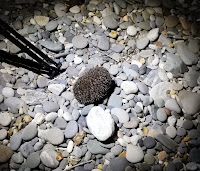The first Little Tern nest was found on the 17th May. The ‘active nest count’ peaked on 27th May with a total of 130 nests, shortly afterwards the number began to decline due to initially undetermined nocturnal predation. Various predators were active around the colony over the course of the season, including; American Mink, Hedgehog, Rook, Red Fox and Peregrine. A total of 68 nests (52% of the colony maximum) were depredated between 27th May – 5th June, during which time two Hedgehogs were observed on the main colony (using thermal imaging optics) and removed. It was concluded that they were responsible for the greatest number of losses during this time having gained access to the colony by entering under the netting along the seaward side in the aftermath of tidal damage. Of the total nest losses during this period, 13 were on the satellite colony south of the breaches, of which, the greatest deficit was incurred by an unidentified nocturnal predator. The confirmed presence of American Mink in the estuary and lagoons throughout the duration of the project meant that predation by this species could not be ruled out. Additionally, sustained opportunistic predation by Rooks caused losses of individual eggs, and high levels of nest abandonments.
 |
| Figure 1. Complete season - active nest trend (Data: BirdWatch Ireland) |
From 22nd – 31st June, the ‘active nest count’ rose,
initially quite rapidly, to 106 on the 23rd . Subsequently the trend
exhibits a brief plateau before continuing to rise steadily to a peak of 111 on
the 31st June. (see Figure 1.
for complete season - active nest trend). Based on colonial observations at
this time, it is suggested that the incumbency of this latest cohort may be a
proportional representation; of relaying birds faithful to the Kilcoole site
and; a contingent from a neighbouring colony at Portrane, Co. Dublin
(tentative). According to reports, circa 30 pairs of Little Terns abandoned
breeding grounds at Portrane around this time, due to high levels of
disturbance by a Fox.
From the 1st June the number of chicks departing their nests grew
continuously, reducing the active nest count, eventually to zero.
A total of 269 chicks were recorded at Kilcoole in 2019 of which 253 were ringed (compared to 257 and 258 in the previous years consecutively). We are confident that ~90% of the total number fledged successfully, with the first fledgling observed taking to the wing on the 28th June. Losses to young birds were attributed to; natural causes (5), unidentified cause (4), lost at sea (1), Peregrine (4), Fox (11). Predation by Peregrine and Fox was especially pronounced towards the end of the season, with the peregrine taking fledglings on the wing and the fox stalking them on the ground by night.
A new nest was discovered as late as the 30th July containing a brood of 2 freshly hatched chicks. It was monitored apprehensively for 3 days until, alas, on the 3rd of August the chicks were gone.
 |
| Juvenile female Peregrine which frequented the colony in July taking at least 4 fledglings. (Photo: Daniele Gioppo) |
During the last few days of wardening duty on the colony some notable sightings were made on or near the site, including; comma butterfly, Green Sandpiper, and Great Egret which rounded proceedings off nicely.
 |
| Left: Comma butterfly. Right: Great Egret and Grey Heron |
 |
| The 2019 Team. L-R: Isabelle, Kevin, Daniele, Eilis,Chris, Alex, Steve, Darren. |



















